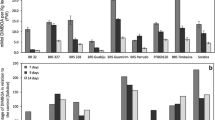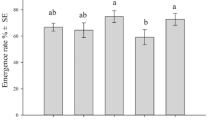Abstract
The influence of hydroxamic acids (Hx), plant secondary metabolites associated with aphid resistance in wheat, on the host acceptance and suitability of the aphid Sitobion avenae to the cereal aphid parasitoid Aphidius rhopalosiphi was evaluated. Aphids showed a reduction in mean relative growth rate and in body size in the wheat cultivar with higher Hx level. Reduction in aphid size was related to a decreased success in avoiding parasitoid oviposition. A minor increase in A. rhopalosiphi developmental time was observed in aphids feeding on the higher Hx cultivar. Experiments with different concentrations of DIMBOA glucoside, the main Hx in wheat, in artificial diets showed an increase in parasitoid developmental time at the highest concentration, with no change in other performance variables. The evidence is discussed in relation to the compatible utilization of host-plant resistance and biological control in integrated pest management.
Similar content being viewed by others
REFERENCES
Braimah, H., and VAN1 Emden, H. F. 1994. The role of the plant in host acceptance by the parasitoid Aphidius rhopalosiphi (Hymenoptera: Braconidae). Bull. Entomol. Res. 84:303–306.
Campos, F., Donskov, N., Arnason, J. T., PhilogÈne, B. J. R., Atkinson, J., Morand, P., and Werstiuk, N. H. 1990. Biological effects and toxicokinetics of DIMBOA in Diadegma terebrans (Hymenoptera: Ichneumonidae), an endoparasitoid of Ostrinia nubilalis (Lepidoptera: Pyralidae). J. Econ. Entomol. 83:356–360.
Escobar, C. A., and Niemeyer, H. M. 1993. Potential of hydroxamic acids in breeding for aphid resistance in wheat. Acta Agric. Scand. Sect. B Soil Pl. 43:163–167.
Febvay, G., Delobel, B., and RahbÉ, Y. 1988. Influence of the amino acid balance on the improvement of an artificial diet for a biotype of Acyrthosiphon pisum (Homoptera: Aphididae). Can. J. Zool. 66:2449–2453.
Fuentes-Contreras, J. E., Powell, W., Wadhams, L. J., Pickett, J. A., and Niemeyer, H. M. 1996. Influence of wheat and oat cultivars on the development of the cereal aphid parasitoid Aphidius rhopalosiphi and the generalist aphid parasitoid Ephedrus plagiator. Ann. Appl. Biol. 128:181–187.
Gerling, D., Roitberg, B. D., and Mackauer, M. 1990. Instar-specific defence of the pea aphid, Acyrthosiphon pisum: Influence on oviposition success of the parasitoid Aphellinus asychis. J. Insect Behav. 3:501–504.
Givovich, A., and Niemeyer, H. M. 1995. Comparison of the effect of hydroxamic acids from wheat on five species of cereal aphids. Entomol. Exp. Appl. 74:115–119.
Givovich, A., SandstrÖm, J., Niemeyer, H. M., and Pettersson, J. 1994. Presence of a hydroxamic acid glucoside in wheat phloem sap, and its consequences for performance of Rhopalosiphum padi (L.) (Homoptera: Aphididae). J. Chem. Ecol. 20:1923–1930.
Gross, P. 1993. Insect behavioral and morphological defenses against parasitoids. Annu. Rev. Entomol. 38:251–273.
Hare, J. D. 1992. Effects of plant variation on herbivore-natural enemy interactions, pp. 278–298, in R. S. Fritz and E. L. Simms (eds.). Plant resistance to herbivores and pathogens: Ecology, evolution and genetics. The University of Chicago Press, Chicago.
Hartenstein, H., Klein, J., and Sicker, D. 1993. Efficient isolation procedure for (2R)-β-D-glucopyranosyloxy-4–hydroxy-7–methoxy-2H-1,4–benzoxazin-3(4H)-one from maize. Indian J. Heterocycl. Chem. 2:151–153.
Klingauf, F. A. 1987. Feeding, adaptation and excretion, pp. 225–253, in A. K. Minks and P. Harrewijn (eds.), Aphids, Their Biology, Natural Enemies and Control. World Crop Pests, Vol. 2A. Elsevier, Amsterdam.
KouamÉ, K. L., and Mackauer, M. 1991. Influence of aphid size, age and behaviour on host choice by the parasitoid wasp Ephedrus californicus: A test of host-size models. Oecologia 88:197–203.
Kuo, H. 1984. Resistance of oats to cereal aphids: Effects on parasitism by Aphellinus asychis (Walker), pp. 125–137, in D. J. Boethel and R. D. Eikenbary (eds.). Interactions of Plant Resistance and Parasitoids and Predators of Insects. Ellis Horwood, Chichester, UK.
Martos, A., Givovich, A., and Niemeyer, H. M. 1992. Effect of DIMBOA, an aphid resistance factor in wheat, on the aphid predator Eriopis connexa Germar (Coleoptera: Coccinellidae). J. Chem. Ecol. 18:469–479.
Messina, F. J., Jones, T. A., and Nielson, D. C. 1995. Host plant affects the interaction between the Russian wheat aphid and a generalist predator, Chrysoperla carnea. J. Kans. Entomol. Soc. 68:313–319.
Niemeyer, H. M. 1990. The role of secondary plant compounds in aphid-host interactions, pp. 187–205, in R. K. Campbell and R. D. Eikenbary (eds.). Aphid-Plant Genotype Interactions. Elsevier, Amsterdam.
Niemeyer, H. M., and PÉrez, F. J. 1995. Potential of hydroxamic acids in the control of cereal pests, diseases and weeds, pp. 260–270, in Inderjit, K. M. M. Dakshini and F. A. Einhellig (eds.). American Chemical Society Symposium Series 582 Allelopathy: Organisms, Processes, and Applications. American Chemical Society, Washington, DC.
Niemeyer, H. M., Pesel, E., Franke, S., and Francke, W. 1989. Ingestion of the benzoxaxinone DIMBOA from wheat plants by aphids. Phytochemistry 28:2307–2310.
Pickett, J. A., Wadhams, L. J., Woodcock, C. M., and Hardie, J. 1992. The chemical ecology of aphids. Annu. Rev. Entomol. 37:67–90.
Powell, W., and Wright, A. F. 1992. The influence of host food plants on host recognition by four aphidiinae parasitoids (Hymenoptera: Braconidae). Bull. Entomol. Res. 81:449–453.
Price, P. W., Bouton, C. E., Gross, P., McPheron, B. A., Thompson, J. N., and Weis, A. E. 1980. Interactions among three trophic levels: influence of plants on the interactions between insect herbivores and natural enemies. Annu. Rev. Ecol. Syst. 11:41–65.
Reed, D. K., Kindler, S. D., and Springer, T. R. 1992. Interactions of Russian wheat aphid a hymenopterous parasitoid and resistant and susceptible slender wheatgrasses. Entomol. Exp. Appl. 64:239–246.
van Emden, H. F., and Wratten, S. D. 1990. Tri-trophic interactions involving plants in the biological control of aphids, pp. 29–43, in D. C. Peters, J. A. Webster, and C. S. Chlouber (eds.). Aphid-Plant Interactions: Populations to Molecules. Oklahoma State University Stillwater, Oklahoma.
Vet, L. E. M., and Dicke, M. 1992. Ecology of infochemical use by natural enemies in a tritrophic context. Annu. Rev. Entomol. 37:141–172.
Weibull, J., and Niemeyer, H. M. 1995. Changes in dihydroxymethoxybenzoxazinone glycoside content in wheat plants infected by three plant pathogenic fungi. Physiol. Mol. Plant Pathol. 47:201–212.
Zadoks, J. C., Chang, T. T., and Konzak, C. F. 1974. A decimal code for the growth stages of cereals. Weed Res. 14:415–421.
Author information
Authors and Affiliations
Rights and permissions
About this article
Cite this article
Fuentes-Contreras, E., Niemeyer, H.M. DIMBOA Glucoside, a Wheat Chemical Defense, Affects Host Acceptance and Suitability of Sitobion avenae to the Cereal Aphid Parasitoid Aphidius rhopalosiphi . J Chem Ecol 24, 371–381 (1998). https://doi.org/10.1023/A:1022592711140
Issue Date:
DOI: https://doi.org/10.1023/A:1022592711140




